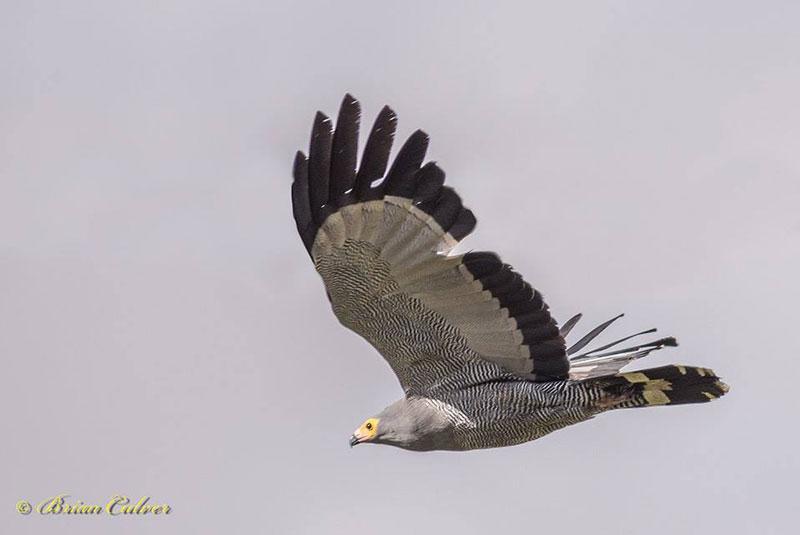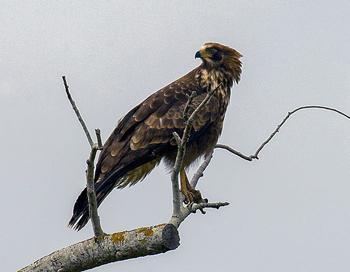African Harrier-Hawk (Overberg Birds)
Botanical Name: Polyboroides typus
Afrikaans name: Kaalwangvalk
The African harrier-hawk, is a bird of prey and is related to the harriers. It breeds in most of Africa south of the Sahara. The only other member of the genus is the allopatric Madagascan harrier-hawk (Polyboroides radiatus).

Identification:
The African harrier-hawk is a medium-sized raptor. The upperparts, head and breast are pale grey. The belly is white with fine dark barring. The broad wings are pale grey with a black trailing edge fringed with a narrow white line. The tail is black with a single broad white band. There is a bare facial patch of variable colour, usually red or yellow. Genders are similar, but young birds have pale brown instead of grey, and dark brown replacing black. An unusual trait of this species is the double-jointed knees it possesses, which enable it to reach into otherwise inaccessible holes and cracks for prey. A comparable leg-structure and behaviour can be found in the Neotropical crane hawk; a case of convergent evolution.
Biometrics: Length: 60-66 cm; Wingspan: 160 cm ; Weight: 635-950g
Juveniles have pale brown plumage, paler on the belly, with dark brown instead black and barred tail.
Chicks are downy buff to orange-brown, and at about 10 days, they are greyish above and white below. They have pale olive grey cere and face whereas legs and feet are greenish yellows.

Distribution and Habitat:
The African harrier-hawk can be found in natural woodland, tree plantations and urban areas.
Behaviour:
Gymnogene is usually solitary. It is specialized in robbing nests of holes nesting birds, with its adaptive flexible knee-joints to facilitate this habit. It can probes crevices and hollows for lizards and larvae, but when it robs weaver’s nests, it hangs upside-down to catch chicks and eggs. To feed on oil palm nuts, it may walk along branches and foliages, feet over feet, using its wings to stabilize it
Main Diet:
The African harrier-hawk is omnivorous, eating the fruit of the oil palm as well as hunting small vertebrates. Its ability to climb, using wings as well as feet, and its long double-jointed legs, enable this bird to raid the nests of cavity-nesters such as barbetsand woodhoopoes for fledglings. It has been known to prey on introduced species such as feral pigeons, house sparrows and eastern gray squirrels.[
Breeding and nesting habits:
It builds a stick nest in the fork of a tree or the crown of a palm tree. The clutch is one to three eggs.
Gymnogene breeds at the end of the dry season, from June to November. Its nest is located at the top of a tree, or in a rocky crevice near the ground.
The nest is a stick platform, with a rim of green fresh leaves, and lined with green sprigs.
Female lays 1 or 2 white eggs. Incubation lasts about 35 days, by both parents. Chicks are fed by both adults, mainly by female with food brought at nest by male. They fledge at about 45 to 55 days.
Voice | sing:
Gymnogene’s call is a weak, plaintive and prolonged whistle “su-eeeee-oo”. But usually, it is a silent bird. Young at nest make a more high-pitched call, a rapid chattering “ki-ki-ki-ki-ki”, while adults utter a “wheep-wheep” near the nest.
Threats | Status | Protection:
Gymnogene is widely distributed in sub-Saharan Africa, except in the arid northern regions.
Source
Text:
- Wikipedia - https://en.wikipedia.org/wiki/African_harrier-hawk
- Oiseaux birds - http://www.oiseaux-birds.com/home-page.html
- Biodiversity Explorer - http://www.biodiversityexplorer.org/
Photos:
Call us and schedule your listing today! Contact Us
Copyright © 2025 Hermanus Online Magazine. Web Development by Jaydee media.

